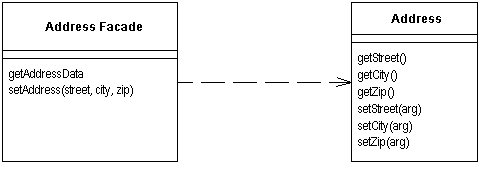http://www.runoob.com/design-pattern/facade-pattern.html
外观模式
外观模式(Facade Pattern)隐藏系统的复杂性,并向客户端提供了一个客户端可以访问系统的接口。这种类型的设计模式属于结构型模式,它向现有的系统添加一个接口,来隐藏系统的复杂性。
这种模式涉及到一个单一的类,该类提供了客户端请求的简化方法和对现有系统类方法的委托调用。
介绍
意图:为子系统中的一组接口提供一个一致的界面,外观模式定义了一个高层接口,这个接口使得这一子系统更加容易使用。
主要解决:降低访问复杂系统的内部子系统时的复杂度,简化客户端与之的接口。
何时使用: 1、客户端不需要知道系统内部的复杂联系,整个系统只需提供一个"接待员"即可。 2、定义系统的入口。
如何解决:客户端不与系统耦合,外观类与系统耦合。
关键代码:在客户端和复杂系统之间再加一层,这一层将调用顺序、依赖关系等处理好。
应用实例: 1、去医院看病,可能要去挂号、门诊、划价、取药,让患者或患者家属觉得很复杂,如果有提供接待人员,只让接待人员来处理,就很方便。 2、JAVA 的三层开发模式。
优点: 1、减少系统相互依赖。 2、提高灵活性。 3、提高了安全性。
缺点:不符合开闭原则,如果要改东西很麻烦,继承重写都不合适。
使用场景: 1、为复杂的模块或子系统提供外界访问的模块。 2、子系统相对独立。 3、预防低水平人员带来的风险。
注意事项:在层次化结构中,可以使用外观模式定义系统中每一层的入口。
https://www.dofactory.com/net/facade-design-pattern
Provide a unified interface to a set of interfaces in a subsystem. Façade defines a higher-level interface that makes the subsystem easier to use.
Participants
The classes and objects participating in this pattern are:
- Facade (MortgageApplication)
- knows which subsystem classes are responsible for a request.
- delegates client requests to appropriate subsystem objects.
- Subsystem classes (Bank, Credit, Loan)
- implement subsystem functionality.
- handle work assigned by the Facade object.
- have no knowledge of the facade and keep no reference to it.
Remote Facade
Provides a coarse-grained facade on fine-grained objects to improve efficiency over a network.
For a full description see P of EAA page 388

Remote Facade In an object-oriented model, you do best with small objects that have small methods. This gives you lots of opportunity for control and substitution of behavior, and to use good intention revealing naming to make an application easier to understand. One of the consequences of such fine-grained behavior is that there's usually a great deal of interaction between objects, and that interac-tion usually requires lots of method invocations.
Within a single address space fine-grained interaction works well, but this happy state does not exist when you make calls between processes. Remote calls are much more expensive because there's a lot more to do: Data may have to be marshaled, security may need to be checked, packets may need to be routed through switches. If the two processes are running on machines on opposite sides of the globe, the speed of light may be a factor. The brutal truth is that any inter-process call is orders of magnitude more expensive than an in-process call - even if both processes are on the same machine. Such a perfor-mance effect cannot be ignored, even for believers in lazy optimization.
As a result any object that's intended to be used as a remote objects needs a coarse-grained interface that minimizes the number of calls needed to get some-thing done. Not only does this affect your method calls, it also affects your objects. Rather than ask for an order and its order lines individually, you need to access and update the order and order lines in a single call. This affects your entire object structure. You give up the clear intention and fine-grained control you get with small objects and small methods. Programming becomes more dif-ficult and your productivity slows.
A Remote Facade is a coarse-grained粗粒度的 facade [Gang of Four] over a web of fine-grained objects. None of the fine-grained objects have a remote interface, and the Remote Facade contains no domain logic. All the Remote Facade does is translate coarse-grained methods onto the underlying fine-grained细粒度的 objects.